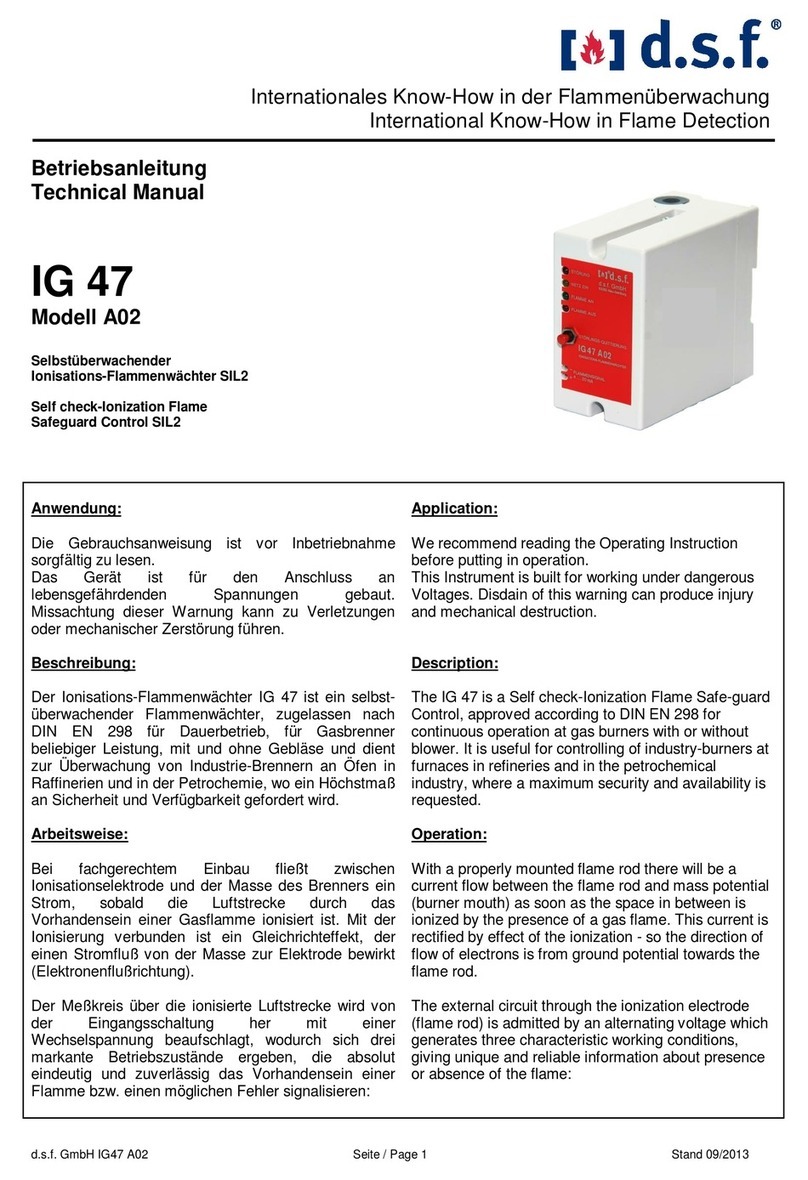Sicherheit bei Bedienung und im Betrieb:
Unsachgemäßer Umgang kann zu erheblichen
Personen- und Sachschäden führen.
Arbeiten an dem Hochenergie-Zündsystem darf nur
entsprechend ausgebildetes Bedienungspersonal oder
eine Elektrofachkraft durchführen.
Bedienungspersonal ist eine Person, die für
Installation, Betrieb, Einrichten, Wartung, Reinigung,
Reparatur oder Transport von Geräten und Maschinen
zuständig ist, so dass sie Gefahren erkennen und
vermeiden kann.
Elektrofachkraft ist eine Person mit geeigneter
fachlicher Ausbildung, Kenntnissen und Erfahrung, so
dass sie Gefahren erkennen und vermeiden kann, die
von der Elektrizität ausgehen können.
Sicherheit bei Lagerung, Montage , Installation und
Wartung
Der einwandfreie und sichere Betrieb des Gerätes setzt
sachgemäßen Transport, fachgerechte Lagerung,
Aufstellung und Montage sowie eine sorgfältige
Bedienung voraus.
Es besteht Lebensgefahr bei Berührung von
spannungsführenden Komponenten, daher ist eine
regelmäßige Sichtkontrolle durch den Anwender
festzulegen. Die Sichtkontrolle beschränkt sich auf die
Unversehrtheit der angeschlossenen Kabel, der
mechanischen Anschlüsse und dem festen Sitz der
Schrauben. Eine gute Erdung ist ein wichtiger
Bestandteil der Funktionsweise. Eine Überprüfung zur
Einhaltung der zulässigen Umgebungstemperaturen ist
erforderlich.
Der Ionisationsflammenwächter darf nur mit
geschlossenem Deckel, im eingebauten Zustand und
mit einem im Feuerraum befindlichen Ionisationsstab
betrieben werden.
In dem Ionisationsflammenwächter wird eine
Spannung von max. 300VAC erzeugt, daher muss bei
der Feststellung einer Beschädigung das
Flammenüberwachungssystems außer Betrieb
genommen und zur Reparatur eingesendet werden.
Vor allen Arbeiten ist die Spannungsversorgung
abzuschalten, gegen Wiedereinschalten zu sichern
und die Spannungsfreiheit zu überprüfen.
Es kann bei einem notwendigen Ausbau des
Ionisationsstabes Verbrennungsgefahr bestehen. Die
Verwendung von Schutzhandschuhen und
Arbeitsschutzkleidung ist erforderlich.
Safety in handling and operation:
Improper handling can lead to considerable personal
injury and material damage.
Work on the high-energy ignition system may only be
carried out by appropriately trained operating
personnel or a qualified electrician.
Operating personnel is a person who is responsible for
the installation, operation, setting up, maintenance,
cleaning, repair or transport of equipment and
machinery so that they can identify and avoid hazards.
A qualified electrician is a person with appropriate
professional training, knowledge and experience so
that he or she can identify and avoid dangers that could
be caused from electricity.
Safety in storage, assembly, installation and
maintenance
The correct and safe operation of the device requires
proper transport, proper storage, installation and
assembly as well as careful operation.
There is a risk of fatal injury if the user touches live
components, therefore a visual inspection by the user
must be specified. The visual inspection is limited to
the integrity of the connected cables, mechanical
connections and a tight fit of the screws. Good
grounding is an important component of the function. A
check to ensure that the permissible ambient
temperatures are maintained is necessary.
When installed, the ionization flame monitor may only
be operated with the lid closed and with an ionization
rod located in the furnace.
The ionization flame monitor generates a voltage of
max. 300VAC, so if damage is detected, the flame
monitoring system must be taken out of service and
sent in for repair. Before carrying out any work, the
power supply must be switched off, secured against re-
switching and checked to ensure voltage-free
operation.
If the ionizing rod needs to be removed, there is a
danger of burns. The use of protective gloves and
protective clothing is required.




























